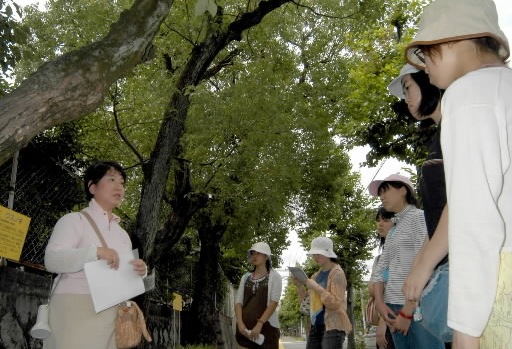Conveying the A-bomb Experience, Part 5
Jul. 5, 2010
Second-generation survivors assume role in bridging generations
by Kunihiko Sakurai, Masaki Kadowaki, and Takahiro Yamase, Staff Writers
The heat of the atomic fire, the agony of burned bodies, the grief wrought by families torn apart, the rage felt toward war… What should be done to etch the experiences borne of that day in our minds and in our memories, for generations to come, as the A-bomb survivors (hibakusha) and the family members of the A-bomb victims age? In this series (originally published in July and August 2004), the Chugoku Shimbun will consider the significance and challenges of conveying the A-bomb experience, with a focus on new efforts taking place in the A-bombed city of Hiroshima.
With the temperature at 33.9 degrees Celsius, Masayo Uemoto, 48, a housewife in Nishi Ward, Hiroshima, raised her voice under the blazing sun so she could be heard among a chorus of chirring cicadas: "These trees were able to withstand the intense heat of the atomic bombing." She was standing in the school yard of Senda Elementary School in downtown Hiroshima, 1.7 kilometers from the hypocenter. Ten high school students from Tokyo, visiting Hiroshima for a peace education program, looked up at the four camphor trees, rustling with fresh, green leaves.
Ms. Uemoto is a second-generation A-bomb survivor. Fifty-nine years ago, her father, 72, suffered burns to his entire body due to the atomic bombing. She grew up, hearing her parents and acquaintances asking each other: "Where were you when the bomb exploded?" She had not directly spoken to her father about his experience of the blast, but she was proud of the idea that "I knew more about the atomic bombing than other people."
However, while taking part in a study session in 1988, invited by a volunteer of Seikyo Hiroshima who guided visitors to A-bomb related monuments, she heard someone in a Kansai dialect describing the monuments and A-bombed buildings in much more detail than she could manage. She felt: "The people of Hiroshima, and the family members of A-bomb victims, in particular, must be able to convey the bombing." Since then, she has read the writings of A-bomb survivors and has become attentive to newspaper articles and TV news that report on international affairs.
About two days a month, Ms. Uemoto serves as a guide for junior high and high school students. Linking these young people, her father, who has begun to show his age, and her own presence, she has realized that "Expectations for second-generation A-bomb survivors are growing more and more." She feels that second-generation survivors, like herself, have a role to play in "building a bridge" between generations. She has begun to ask her father, slowly but surely, about his painful memories.
Keiko Hasegawa, 39, is a Hiroshima "peace volunteer" who guides visitors through Hiroshima Peace Memorial Museum. She is a second-generation A-bomb survivor and a resident of the city of Hatsukaichi. Six years ago, in the summer, she visited the museum with her twin sons, who were six years old at the time. While looking at the many A-bomb artifacts, the feeling welled up inside her that "Although I'm a citizen of Hiroshima, I'm unable to explain such things to my children." The following year, thinking "I'm in a position to hand down the sorrow of the A-bomb victims whose futures were stolen from them," she began her activity.
Once a week, Ms. Hasegawa serves as a guide at the museum, standing before the A-bomb artifacts and explaining the historical background and conditions at the time to visitors. She feels impatient, though: "Unless we do something, the atomic bombing will not be handed down to the future." At the same time, she worries: Will the suffering of her father, 71, and others caused by the atomic bombing be properly conveyed? Will her words move the hearts of those who listen to her? What should she say and how should she express herself in order to be persuasive?
Ms. Hasegawa has never faced her father to ask about his experience of the atomic bombing. She hesitates to do so, thinking it may be cruel of her to remind him of the experience. At this point, all she can manage is the appeal: "Someday please tell children about your experience."
Masayuki Taguchi, 47, is an electrician who has served as the leader of about 110 second-generation A-bomb survivors in the city of Miyoshi. He has held a number of readings of the A-bomb accounts of their parents, among other events, as he felt it was difficult for the second-generation survivors to convey the atomic bombing in their own words.
Now he thinks: "Nearly 60 years later, the atomic bombing still torments our fathers and mothers. Because we have seen them closely as we grew into adults, we should speak frankly about our parents' suffering and our own feelings. Perhaps this is our role to play as second-generation A-bomb survivors."
(Originally published on July 26, 2004)








